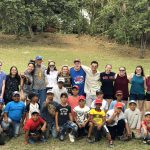
This gallery contains 11 photos.


This gallery contains 11 photos.
Our last day in Cuba was meant to be spent exploring Cuba independently; I felt as if I had already experienced everything but wanted to do it all again before we had to leave. We crammed every possible adventure into our last twenty-four hours. Now, thinking about the New England cold as an eight-inch snowfall looms over our return, I want our jam-packed final day to last as long as it possibly can.

Abby and Liam, thrilled to be riding the ferry.
I started my day on a packed ferry to Regla, visiting the museum of Santeria, a religion developed in Cuba by the Yoruba people as a way to merge their religion with the Catholicism that was forced upon them by the Spaniards colonizing the island. Santeria has adapted Christian symbols, including the use of Lazarus as a god, a virgin mother figure, and crucifix figures scattered throughout the art in the museum. I found the way that Santeria grew as a way to adapt to the rule of Cuba at the time interesting, and an example of a common theme that I found throughout my trip: Cubans have to adapt to whatever power is trying to exert itself upon them.

“The Yoruba people played an important role in the history and culture not only of Nigeria, but of all sub-Saharan Africa.”
Cubans first fought for independence from Spain in the Ten Years War, which Americans know as the Spanish-American War, in our typical fashion of erasing Cuba’s presence. Within the next century, they had to again fight for independence from their own (American-backed) government and have spent the sixty years since surviving under what they call a blockade from the United States. I think that what Santeria and Cuba’s political history show is that Cuba is a nation that will not allow themselves to be stepped on. As our wise guide said during a visit to the Museum of the Revolution: “This is our sh**, let it be our sh**.”
A convertible ride back to our residencia brought me back from my admiration of Cuba’s resilience and to my goal for the day: to experience as much as I could again before our two short weeks in Havana ended. After lunch, a group of us walked to Café O’Reilly, a coffee shop that had become one of my favorite places to relax for an hour. On the way, we met a man that gave us directions to Old Havana and discussed his experience in Cuba. He worked in creating curriculum for public schools and angrily ended our conversation when we mentioned the coffee shop, asking us why Americans chose to frequent government-run shops instead of supporting small private businesses. Even though we had eaten at multiple paladars, privately-owned restaurants, I had almost forgotten that not everyone in Cuba is happy with the socialist government.

Our last taxi ride.
After our final coffee shop visit, which was a reminder of the scarcity of some resources in Cuba when the shop didn’t have the condensed milk needed for a Café Tres Leches, my favorite drink there, we walked through the packed streets of Old Havana one last time. I found an aviary that I had probably walked by every day but hadn’t noticed. It made me realize how much I had probably missed. (And made me begin to plan a return trip to experience everything that I may have distractedly passed by.) We took a newer cab back to the residencia to meet for our farewell dinner. The ability to ride in an antique car from the 1950’s and a newer Audi in the same day never stopped amazing me; I expected every car in Cuba to be antique, and the newer models proved that Cuba is moving forward much more than I had expected.
Our farewell dinner had me more focused on conversation than on the (insanely delicious) food that we were enjoying. It’s strange to spend two weeks with the same twelve people, and barely any contact with the outside world, and then expect to go back to normal life at home. These past two weeks weren’t just about going to class and exploring Cuban museums, they were about immersing ourselves in an unfamiliar country and culture and trying to absorb as much of it as possible. Part of that immersion was forming the relationships that we did, even if it was a father-son bond with our bus driver, Arturo. Receiving certificates of completion from the CEM, (Centro de Estudios Martianos) where we attended lectures, made the end of this adventure feel real. Cuba will always be a part of all of us, in the memories, souvenirs, and slightly-too-close-up photos of each other, but especially in the friendships that we’ll maintain when we come home.
[“You’ve Got a Friend in Me” from Toy Story plays quietly in the background.]
On this day, we had a lecture on Race in Cuba and visited a farm-to-table restaurant owned and run by an Italian immigrant.
Tomas Fernandez Robaina was the lecturer for the day. Tomas, or Tomasito, as his friends call him for his short stature and affable demeanor, has studied race for decades. According to him, he has taken twenty-five trips to the United States to study with various higher education institutes discussing the complex manifestations of race and race relations in the Republic of Cuba. He has visited such universities as Amherst College and Harvard. When asked about African American writers who were the most influential in his studies abroad, he cited W.E.B Dubois and Booker T. Washington.
The story of race in Cuba is very similar to the one in the United States in that race has been a determinant factor in social status for darker citizens. Slavery was not outlawed in Cuba until nearly two decades after the United States Civil War. Similar to the United States history, the military appears to be the first of the social and governmental institutions to integrate.
The effects of racism were most notably pointed out by the islands most famous political and social thinker: Jose Marti. His essay “Our Race” is thought to capture the true essence of the Cuban disposition toward race. In the essay, Marti calls for unity among the racial factions in order to oppose the threatening forces of the Spanish Colonizers and proposes even broader positive consequences for unification. He denounces divisive attitudes between the races and propositions an ideal of harmony and brotherhood among all Cuban peoples.
There are varying degrees and appearances of racism: structural and implicit, or cultural and blatant. Since the colonization of Latin American countries by Spain, degrees or classes of race have become the norm. Mixed race peoples know greater privilege and priority in the hierarchical social structure. In total, there have been reported more than 40 classes of race in the Spanish colonial caste system. Professor Robaina’s mother was white and his father black, in Cuban society, he is not considered “black” the way he might in America society.
Following the successful attainment of power by Fidel Castro and the communist revolution, Castro declared his intent to end racism. Just two years after his initial claim, Castro announced that racism has been eradicated; a claim which is now contested by many who once accepted his findings. Robaina himself believed the narrative proposed by Castro. In his eyes, there was empirical proof: Blacks were inhabiting political, social, and occupation roles they were formerly barred from. It appeared that structural racism and discrimination had been so thoroughly and effectively combated that Cuba ought to be considered and in-fact considered itself post racial.
Robaina is now convinced that this is not the case. Like scholars of race in the United states, Roabina is interested in the influence of different cultural institutions on the conceptual institutions of race including art and religion. He studies hip-hop, one media through which denizens express their discontent with what they perceive as racial inequality and its discourse about race. Additionally, he discusses the tradition of the Yoruba tribe, some of whom were brought to Cuba as an enslaved people. The modern descendants of these people practice Santeria which is a modification of two religions: Catholicism (which was forced upon enslaved peoples) and traditional Yoruba religious teachings.
After our race lecture, we visited the only farm-to-table restaurant, Meditteraneo Habana, in Cuba- which developed in response to the lack of consistent access to goods on the island. Their options offered for a main course meal all sounded tantalizing and our table, which included Victoria, Katrina, Jen, and I, circumvented the stress of having to choose between courses by agreeing to each order a different dish so that we might share and get a taste of each. I can sincerely attest to the quality and craftsmanship of this small eatery. We tasted homemade spinach ravioli, handmade pizza, and succulent kabobs.
The restaurant, we learned, acted to advise farmers on which crops to grow sell. By the time we visited, the relationship between the growers and chefs had developed well enough to sustain their restaurant independent of state produce.
Our entire educational and culinary experience in Cuba was enough to warrant a second return. One gets the sense that Habana is solely the “tip of the iceberg” when it comes to novel practices of human thriving. For myself, I have been trying to finagle my way back by petitioning my department to sponsor a trip in collaboration with the University of Habana, which potentially could be offered as an senior capstone option for Philosophy majors. We shall see where that leads, but in the meantime, I still have my memories and photos to reminisce on a time spent in a complicated paradise.
This day was packed full of activities. By now we were accustomed to living in Havana and ready to explore more that the city had to offer, including the vibrant art culture. This day included trips to various famous art venues: the Museo de Bellas Artes, the Gran Teatro de la Habana Alicia Alonzo, as well as Club 1830, and then the beauty of the natural world: the beach.
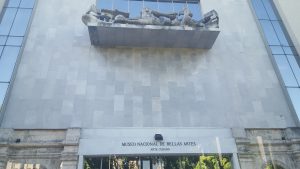
Museum of Fine Art, Havana.
The first place we went was the Museo Nacional de Bellas Artes. This is the national museum of art located across from the Museum of the Revolution. This museum featured Cuban art from every period of Cuban history. The art was much more beautiful than I anticipated. I found that while it had a certain European style, it also had a distinct Cuban approach. Some of my favorite works that I saw included: Servando Cabrera Moreno’s Milicias campesinas, Marcelo Pogolotti’s El intellectual o Joven intellectual, and Victor Manuel García’s Gitana tropical and Río San Juan. Many of these paintings created by Cuban artists was nothing like I have ever seen before. There were also many sculptures throughout the museum. I also really liked that one of the exhibits featured art created by Cuban kids. This exhibit was really cool because it focused on Cuban kids’ art while at the same time providing a history lesson to Cubans and tourists alike.

Servando Cabrera Moreno’s Milicias campesinas, 1961.
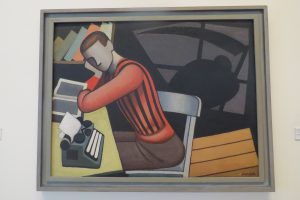
Marcelo Pogolotti’s El intellectual o Joven intellectual, 1937.
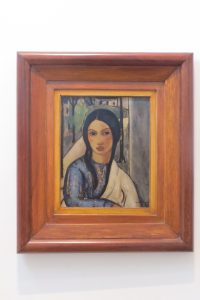
Victor Manuel García’s Gitana tropical, 1929. Also known as the “Cuban Mona Lisa”.

Victor Manuel García’s Río San Juan, 1943.
Another interesting exhibit at the museum was the “El Hueco, un espacio del Arte contra la Injusticia” (A space for art against injustice). This space was created for every person to reflect on the punishment of solitary confinement of seventeen months imposed on the Cuban Five by the United States. This exhibit featured watercolor pieces done by the members of the Cuban Five. This installation was meant to give Cubans a firsthand account of the terrible experience endured by the Cuban Five. While we did not get to go in, as it was closed, this exhibit was sobering to experience nevertheless. It was impossible to imagine what life was like for the Cuban Five in solitary confinement, but instead of responding with violence, they responded with art and a warning for the future. Similar atrocities should never be repeated and this exhibit serves as a reminder to the public to never forget.

“El Hueco, un espacio del Arte contra la Injusticia”
After the art museum, we traveled about thirty minutes outside of Havana to a beautiful beach. The water was warm and a beautiful shade of turquoise blue. It was one of the most beautiful beaches that I have been to in my life. The beach offered me a chance to relax after a long week of going nonstop. After swimming for an hour or so, a few of us decided to take a walk down the beach. Along our walk, each of us collected pieces of sea glass and pretty shells that we found in the beach sands and among the seaweed. There is nothing better than enjoying a warm day on a tropical beach when everyone back home was experiencing winter weather.

Blue skies and turquoise waters.
After the beach, we went back to the Gran Teatro de la Habana Alicia Alonso. We had visited this the day before to see Swan Lake performed by the Cuban National Ballet. We were lucky enough to purchase seats in a box on the left side of the theater the day before. The costumes were spectacular, and equally magnificent was the backdrops created for the various settings of the ballet. The dancers were stunning, their footwork was impeccable and the entire performance I watched with awe as they danced through complicated footwork and graceful leaps. Before visiting Cuba, I did not realize there even was a national ballet company and did not realize that I would be lucky enough to witness a performance firsthand. It is an experience that I will never forget.

Program posted outside the Opera House.
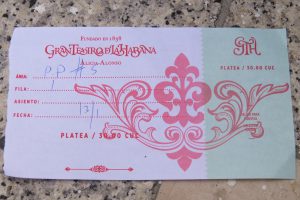
Ticket for Swan Lake Ballet.

Inside the Opera House, before the first act began.
Even later that night, we went to Club 1830 in Havana. This club is known for outdoor salsa dancing by the water. It was a chance for us to interact with the locals and try out our salsa dancing skills with them. The club was full of energy and blasting Cuban music. The energy of this place was absolutely amazing. Everyone was dancing, laughing, and generally having a good time. Many of us stayed until the early hours of the morning.
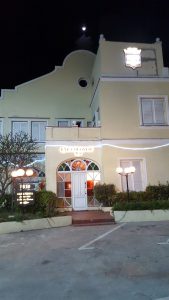
Outside Club 1830.
This day in Cuba was absolutely one of my favorites. We got to do so many exciting things and experience a vibrant Cuba filled with art and music and sun. The fine arts museum was more amazing than I though it would be. It was full of beautiful pieces of art created by painters that I never heard of before coming to Cuba. Swan Lake was one of the most beautiful performances, either ballet, play, or musical that I have ever seen. Everyone was sure to remember their few hours at the beach because most of us left with sunburns, in January. It was one of the most memorable days of the trip.
This was the second Saturday of our stay in Havana. This meant that we had become familiar with places around the city that we enjoyed spending time at, and we started to develop habits around the types of things we would do during our free time.
This day began with a field trip to the opera house in Old Havana. Many of the buildings we had seen and toured by this point were elegant, but somewhat run down and neglected. Walking into the opera house amazed all of us at first sight. The main stairway was stunning and well kept. The grand foyer had photos of the ballet dancers displayed around for viewers to gaze at. It was interesting how much the Cuban government and people valued these forms of art which were evident by the amount of work and money invested into maintaining the building and developing the performances. Because several of us were so impressed by the impression we were given of the performers and space, we decided to buy tickets to see Swan Lake another night.
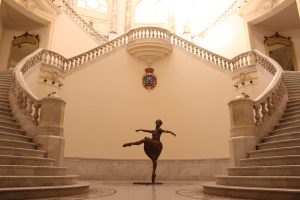
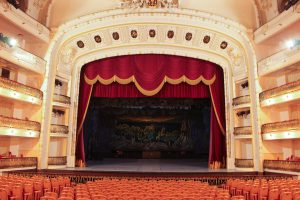


After our tour of the opera house, we were allotted several hours of independent exploration time to explore Old Havana. My roommate Denia and I decided that we wanted to go back to a lunch spot that we were introduced to on one of the first group lunches in the city. The restaurant was a paladar, a privately owned and operated restaurant. One of increasingly many permitted by the Cuban government. It was a small place that looked old and rustic on the outside, but modern and trendy on the inside. It was located on the second floor and had a balcony where Denia and I sat. She ordered shrimp, and I ordered Ropa Vieja. Our meals came with rice, beans, and a salad. We really enjoyed the food and the atmosphere of the place. We could see all on the busy side street below us, and we even engaged in a conversation with some waiters at the street corner trying to catch wandering tourists to point them in the direction of their restaurant. 
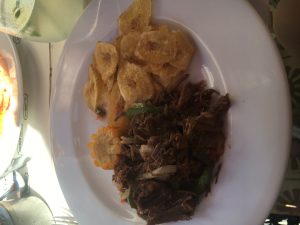
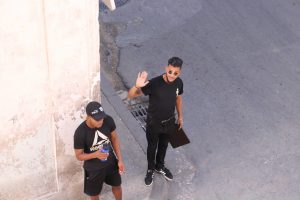

After our meal, we spent the rest of our free time roaming new streets in Old Havana, trying to see if there were more shops full of artwork that he hadn’t seen before. We had just spent time in a familiar place and we wanted to see more of what the city had to offer, so we hit the streets with open eyes. Along the way, we saw some people working on putting stones in the streets and even a man sharpening a knife using a bike.

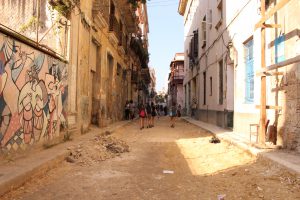


When it was time to meet up with the group again, we started walking towards the waterfront to meet at the Rom Museum. The tour at the museum was quite interesting. Among the many things we learned, we learned that sugar cane came from Asia, not the Caribbean, but because the climate conditions were so good, the sugar cane industry exploded in Cuba. We also learned about the old and new techniques for making rum. This was also a very modern place, that looked rustic on the inside, but very well kept on the inside.
This day also happened to be Denia’s birthday, so at dinner back at the Residencia, she was surprised with a cake that our API coordinator bought for her. This was a great moment and we all really felt like a family coming together over the past week.
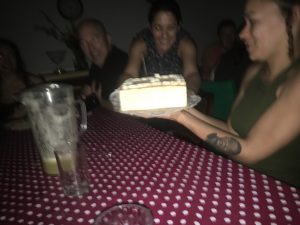
Later that night, our professor wanted to take us through a long walk in Central Havana to a famous rooftop restaurant that he had fallen in love with because of the views of the city. It had been featured in the film Strawberry & Chocolate, the only Cuban movie to ever be nominated for Best Foreign Film at the Academy Awards. It was not only a new and enjoyable experience to be in the atmosphere of the rooftop, but it was also a fun journey to walk there in the heat of the night. We saw a lot of local people playing music and dancing and singing half in their doorsteps and half in the street. We saw many men sitting around a folding table under a streetlamp playing dominos. It was cool to witness what life on a normal neighborhood street feels life vs. one that is catered towards and inviting to tourists, like those in Old Havana.

After we spent some time at the rooftop, our professor took us to another place not too far down the street where Andrew went up on a stage and told some jokes while the rest of us chatted and played card games to enjoy the night the time we had together.

This day was full of breaking from the patterns and exploring the unfamiliar. Each time we found something new, we were pleasantly surprised and impressed by what we found. The places that we discovered that day ended up being places that we wanted to return to later. On other days we went back to the waterfront to take the ferry across the water, and we went back to the rooftop to see the view in the daylight and sunset, for the spectacular colors on the buildings.